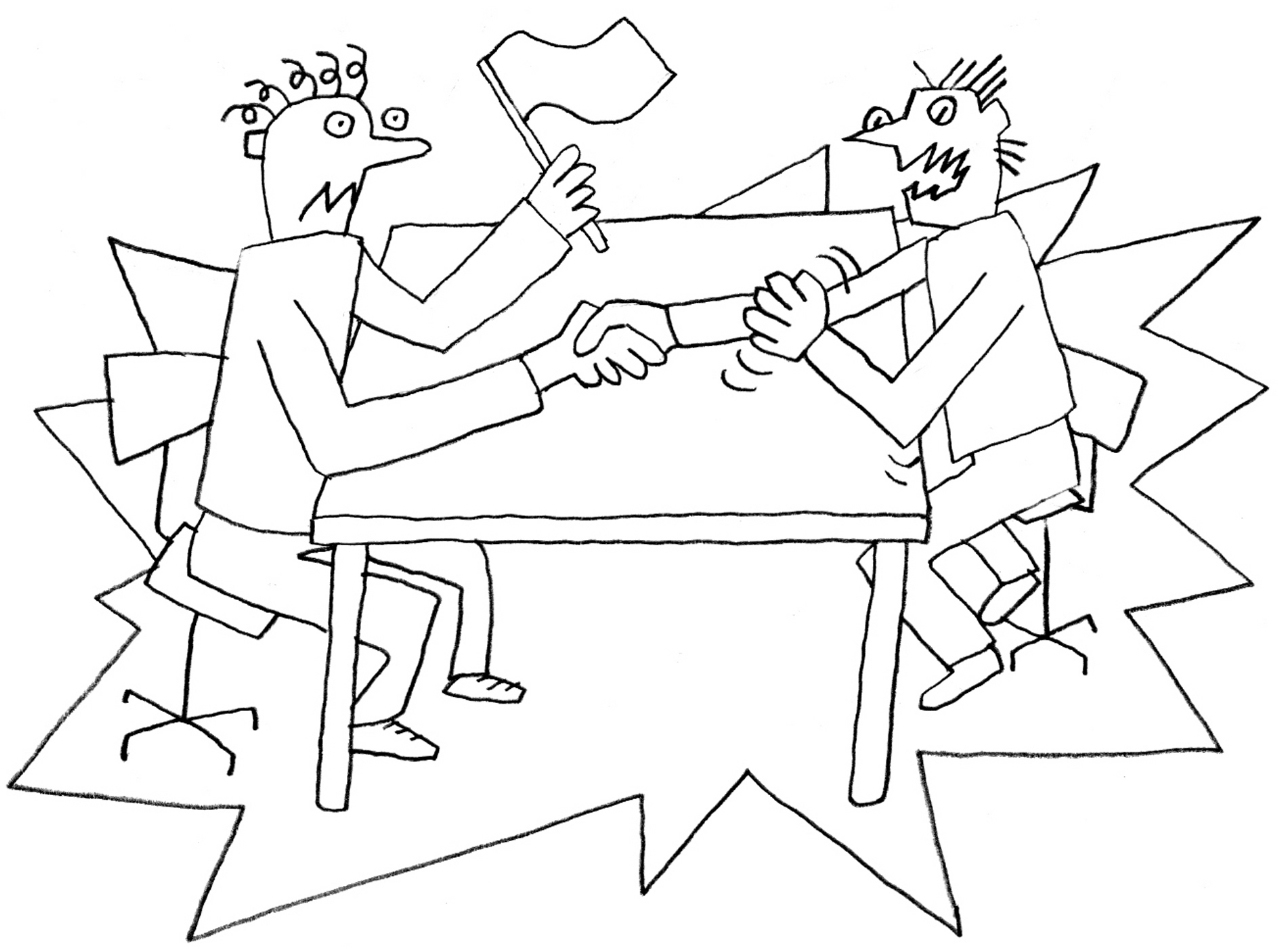
Introduction
The illustration shows two young men engaged in a quarrel. They are sitting opposite each other at a table. One is waving a flag, the other is clenching his fist, baring his teeth. Their hair is raised, which gives the opponents a fierce, beast-like look. If this was all, then we would expect this conflict to escalate: the two men would soon get up and resort to physical violence. But there is a second dement in the picture: the two men are shaking hands, as a sign of agreement and compromise. They are only talking – perhaps shouting at each other – but there is no violence.
The picture shows simultaneously what takes place successively in real life: if we stand up for our interests, opinions and values, we will sometimes get involved in conflict. To resolve such conflicts, we must be able and willing to find an agreement and also strike a compromise. Arguing first and marking the extremes, and then looking for an agreement and compromise, comprises a process of conflict like breathing in and breathing out.
The star-shaped floor may also be meaningful. We share one community – for example our planet, our family, our school. We have no other. Therefore we depend on each other and carrying out conflicts and resolving them must be governed by shared principles and rules. Conflict as such is nothing bad. Human rights produce a pluralism and competition of interests, which increases the likelihood of conflict. Good conflict resolution can lead to harmony, while the attempt to suppress conflict by authoritarian means or resolve it unfairly can lead to the disruption of a community.
Conflict resolution is, to a certain extent, a skill that can be taught. This is one focus of the exercises in this chapter; they provide the learner with tools, structured schemes of procedure, for conflict resolution and mediation. Secondly, fairness of conflict resolution is important, and this refers to the values and the culture of conflict behaviour. Ideally, a conflict should be overcome by a win-win situation. If that is not possible, care must be taken not to produce losers, but rather to find a compromise that maintains a balance in sharing benefits and disadvantages. Viewed from a wider perspective, the potential stakeholders include not only the opponents who are directly involved, but also the community and the environment as a whole.
- Exercise 8.1. - Win-win solutions
Educational objective The students understand that a conflict can be resolved in different ways. The parties involved may be in the position...
- Exercise 8.2. - A structured approach to conflict resolution
Educational objective The students learn a technique of conflict resolution. They understand that resolving conflicts depends to a certain degree on skills...
- Exercise 8.3. - Family and peer conflict
Educational objective The students learn about solving conflicts in a structured manner. Resources Set of student handouts: “Resolution of conflicts in six...
- Exercise 8.4. - Brainstorming session on conflict and peace
Educational objectives The students can define the concepts of conflict and peace. The students can explain which kinds of conflict can be...
- Exercise 8.5. - The statues
Educational objective The students are able to identify situations of oppression, to develop creativity in non-violent conflict resolution and to use body...
- Exercise 8.6. - Punishment versus positive conflict resolution
Educational objectives The students are encouraged to accept the notion of law and of rules in a group. The students are able...
- Exercise 8.7. - Minorities
Educational objective The students understand that the sense of exclusion can be the result not only of the way other members of...
- Exercise 8.8. - Images of war and peace
Educational objectives The students can define aspects of war and peace. The students develop the skill of reading images. The students are...

